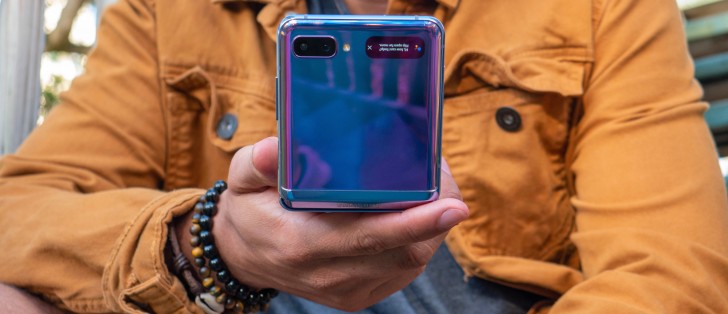Samsung Galaxy Z Flip review

Dual 12MP cameras
Although the Galaxy Z Flip starts a new lineup of flagships, the camera hardware sees a couple of compromises compared to Samsung's Galaxy S flagships. The form factor has imposed additional size constraints on the space available to fit the camera, so the camera hardware on the Z Flip is closer to the Samsung Galaxy S10's rather than S20's. The 12MP main camera has the same sensor and pixel size like the S10, but remember that the Galaxy S10 had a switching aperture while the Z Flip does not.

For the Z Flip, Samsung went with dual 12MP cameras. The main one has an f/1.8 aperture lens, 1.4-micron pixels, Dual Pixel autofocus, and optical image stabilization. The secondary camera is an ultra-wide with f2.2 aperture and 1.12-micron pixels. There is also a bright LED flash, and the cover display becomes a viewfinder for selfies with the main camera - more on that in a bit.
Around the front is a 10MP selfie camera with f/2.4 aperture. By default, the selfie camera crops in a little bit. If you switch to the wide view, this is when you'll get the advertised 10MP images. Otherwise, the Camera app will automatically switch to the slightly wider view when it detects more faces are going to be in a selfie.

The camera app looks like that of other Samsung smartphones with One UI 2.0. You can swipe left and right to switch between shooting modes and swiping vertically will switch between the selfie camera and the main shooter.
The top row offers different options depending on the shooting mode. In most modes, you can select a different aspect ratio, toggle motion photos, and the magic wand button lets you apply filters or beauty correction.
The camera's settings offer control of things like video resolution, grid lines, location data, and there's an experimental option for recording video in HDR+. You can enable RAW capture when shooting in Pro mode, and you can completely disable the Scene Optimizer. You can also toggle the Flex Mode feature with the camera app.
There is some functionality with Flex Mode and the Camera app. You can prop the phone up and angle it without needing a tripod, which makes it useful for hands-free selfies and videos provided that you can get it to an appropriate height; selfies shot from desk height may not make for a very flattering angle.
Flex Mode is great for shooting a Hyperlapse though, as there's no need to prop it up against anything. Something interesting is that the Z Flip will record horizontal video when in Flex mode, but you should know that doing this will crop the video compared to shooting it while laying the phone flexed on its side.

Image quality
Although the Galaxy Z Flip's hardware is close to that of the Galaxy S9's, Samsung's image processing has had some time to mature since then. The resulting images are nice with well-rounded colors, excellent dynamic range, and plentiful details.
HDR kicks in automatically and when it does, it does a great job of blending exposures without clipping highlights - even when the camera is pointing directly into the sun.
We did notice that photos are sometimes a tad oversharpened, which results in some pixelated edges of buildings, pillars, and patterns like bricks and pavers in the ground. Images indoors can sometimes show noise in the darker areas, and details can sometimes be totally lost here.
Now let's check out how the ultrawide camera did.
The ultrawide photos are consistent with the colors and white balance of the main camera, which is a great start. Images are noticeably softer, but especially in lower light since it does use a dimmer aperture compared to the main camera.
Low light performance is where things get a little shaky for the Galaxy Z Flip. Smartphones in the last year or so are being equipped with higher resolution sensors, which noticeably improve low-light performance with the help of pixel binning.
Here are the same shots with Night View enabled. The long exposure does drastically improve the details and colors of the shot, but we found it was trying to go for brighter exposures, thus making some shots look unnatural.
Overall, Night View did its job - it took multiple shots of a night scene to make out more details and exposure, particularly in the shadows. However, we feel like these images could look slightly better if the camera was not putting such a heavy foot on the ISO.
Ultrawide shots captured far fewer details, as expected. However, as in daylight photos, the ultrawide was consistent in white balance and colors as the main camera renders them.
Night View was a definite improvement for the ultra-wide camera. Details come through clearer and lines are cleaner throughout the scene.




Ultrawide camera with Night View
Portraits
There's no ToF sensor equipped on the Galaxy Z Flip, so the way it calculates how it should apply bokeh around a subject will depend entirely on software. With that software, though, there are plenty of things that you can do to change the look of your portrait shot.
Samsung has always offered facial smoothening on its camera, and you can adjust its intensity when shooting in portrait mode. You can also adjust the type of blur, as well as the amount of blur.





Live Focus: Blur • Circle • Spin • Zoom • Color point
The bokeh around the subject is certainly convincing in the default blur effect. The synthesized line seems a bit more noticeable with some of the other Live Focus effects other than the Color point, which does a good job of keeping color on the subject.
Selfie camera
The Galaxy Z Flip uses a 10MP front-facing camera that's cut out of the main display. It features an f/2.4 aperture lens with 1.22-micron pixels. This 10MP camera has two modes: it has a crop and full view mode. The cropped view is set by default while the wider view automatically kicks in when the camera detects more than one face in the viewfinder.
This is interesting because both the crop view and full view output 10MP images, so the camera is up-scaling the cropped view instead of just showing you the full view by default. For this reason, all our selfie samples were shot in the full view.
Here are a couple of selfies in the cropped view, so that you can see the difference.
Selfies aren't extraordinary, but they are flattering and smoothen facial features. The dynamic range is quite good, as well as skin tones and colors. Details are good, but nothing out of this world. Let's see how well the front-facing camera can do with Live Focus images.
These Live Focus images synthesized a convincing bokeh line around the subject if there's enough light and there's a clear separation of the subject from the foreground. Like the main camera, you can also use any of the funky bokeh modes for a more dramatic effect.




Live Focus bokeh mode: Circles • Spin • Zoom • Color point
Taking selfies from the cover display
The Samsung Galaxy Z Flip lets you shoot selfies using either of the main cameras. A double-press of the power button fires up the rear cameras, and the cover display begins feeding you a live view of the camera. A nice feature, though the aspect ratios of the camera and the viewfinder don't match, so you'll only really be able to use this viewfinder to make sure your face is actually in the frame. It won't let you see what's above and below.

Since you're technically holding the camera vertically when taking these selfies, the camera will crop to a 1:1 aspect ratio, regardless of which orientation you hold it. This only happens when shooting selfies through the cover display, and there's no option to change it.
Selfies from the main camera look significantly better than the internal camera's. Details are far more abundant, while colors are noticeably more vibrant with excellent dynamic range. Given the tight crop of this camera from arm's length, you may only be able to fit three people in the frame.



Selfies from main camera are cropped 1 to 1
Now if you want the option to shoot with the ultrawide camera when the phone's closed, that's available, too. To do this, you can simply tap on the cover screen while the viewfinder is open. The question is: should you? Well it depends on how many people you're trying to pose in a selfie with.
The ideal angle to shoot selfies from the ultrawide camera is by holding the phone at about a 45-degree angle upwards, pointing down towards you or your group of friends. This will balance out the body-to-head size ratio - which doesn't work out well from eye level as you can see below.



Selfies with the ultrawide camera
The heavy distortion messes with perception, especially of the arm of the person who is holding the phone. The result is a large body with a tiny head. On another note, the ultrawide camera doesn't capture as much detail of a person's face from arm's length.
Video
The 12MP main camera can record up to 4K resolution video at 60 fps (even the front-facing camera can!), but the ultrawide camera is limited to 30 fps in both 1080p and 4K video.
There are a few video modes to choose from, and there's also Samsung's Super Steady video mode. Super Steady video defaults to 1080p resolution and will only shoot video from the ultrawide camera. Then there's a Night Hyperlapse video mode that makes it possible to take time-lapses of car lights as they pass through a frame.
You can shoot video in Flex Mode, and you even have the option of inverting the aspect ratio to shoot widescreen 16:9 video with the phone sitting upright, but since you are shooting on the shorter dimension, it will be further cropped than if you shot along the camera's native orientation.
4K video image quality is quite good. The dynamic range is great, and the foliage looks good. Autofocus keeps its lock and doesn't hunt for no reason. Colors are otherwise accurate for this overcast scene.
The Z Flip also records 4K video in up to 60fps as well. Compared to the video above, the 60fps mode shows a lot of detail, though some noise can be seen from processing the extra number of frames. The dynamic range looks great throughout this scene.
4K video at 30 frames per second records at about 43.5 Mbps while 60 frames at 4K records at about 72 Mbps.
1080p video is good too, though once again softened by the overcast. It's worth noting that the 60fps mode record at around 28.2 Mbps while the 30fps does just 17.2 Mbps.
Video shot in 1080p at 60 frames per second looked just as good as the regular mode.
We also tested Samsung's Super steady video. While the stabilization itself is great, the quality suffers a bit as videos are shot through the ultrawide camera, and that's especially noticeable in low light. Super steady video is limited to recording in 1080p at 30 frames per second.
Reader comments
- Gypsy
- 08 Dec 2022
- QsC
Phone has cracked in the middle...I would NOT recommend this phone to anyone!! I did not take the warranty due to (normally solid) Samsung quality, however they missed the boat on this one.
- Anonymous
- 13 Nov 2022
- Ix2
Buy the warranty it' worth it ,I got mind changed for only $130.00 And I got a replacement 2 times already.
- john
- 07 Nov 2022
- XVf
can i have you number please i want to talk you about that please. Because i am going to purchase that one mobile





























































